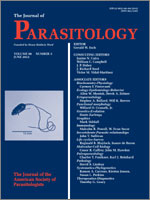The mature spermatozoon of Bothriocotyle sp. is filiform and tapered at both extremities. It possesses 2 axonemes of unequal length, showing the 9 “1” pattern of Trepaxonemata. The anterior extremity exhibits a crest-like body. Thereafter, the crest-like body disappears, and the first axoneme is surrounded by a ring of cortical microtubules (about 27 units) that persist until the appearance of the second axoneme. This ring of cortical microtubules is characteristic only for species of Bothriocephalidea and represents a very useful phylogenetic character. The spermatozoon cytoplasm is slightly electron-dense and contains numerous electron-dense granules of glycogen in several regions. The anterior and posterior extremities of the spermatozoon lack cortical microtubules. The posterior extremity of the spermatozoon of Bothriocotyle sp. possesses a nucleus and a disorganized axoneme, which also characterizes spermatozoa of the Echinophallidae studied to date.
How to translate text using browser tools
1 June 2012
Ultrastructure of the Spermatozoon of Bothriocotyle SP. (Cestoda: Bothriocephalidea), A Parasite of Schedophilus velaini (Sauvage, 1879) (Perciformes: Centrolophidae) In Senegal
Aïssatou Bâ,
Yann Quilichini,
Papa Ibnou Ndiaye,
Cheikh Tidiane Bâ,
Bernard Marchand
ACCESS THE FULL ARTICLE

Journal of Parasitology
Vol. 98 • No. 3
June 2012
Vol. 98 • No. 3
June 2012





